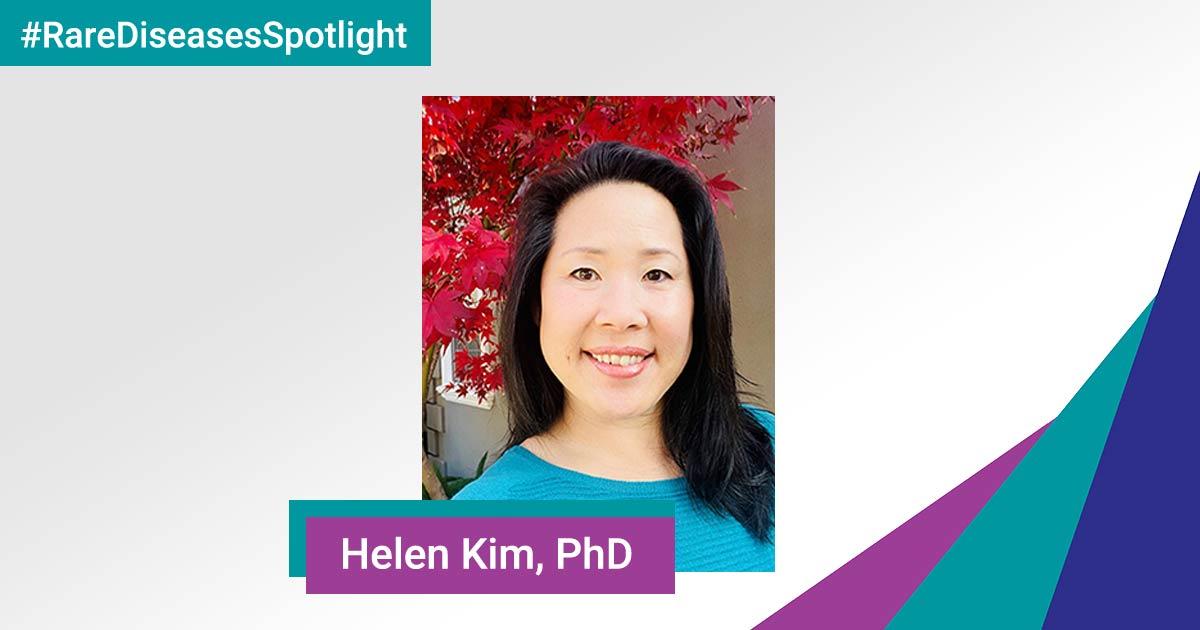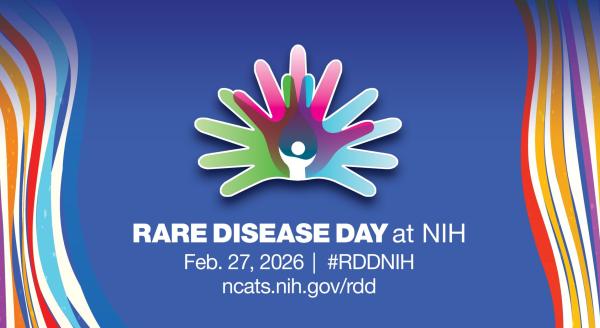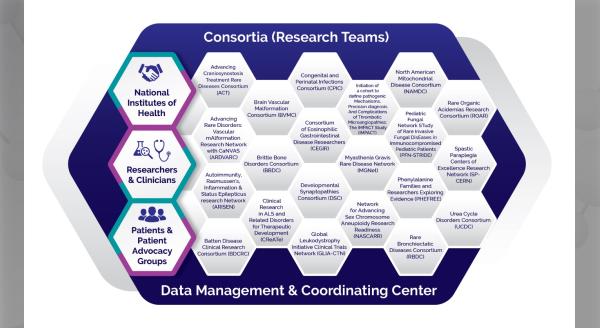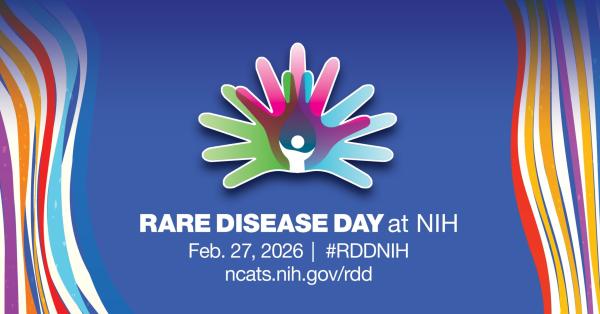Since its initial funding in 2009, the Brain Vascular Malformation Consortium (BVMC) has conducted clinical research and improved the care of patients with brain vascular malformations, conditions in which blood vessels of the brain are affected. Here, Helen Kim, PhD, principal investigator of the BVMC, shares the history of the consortium, current research, and future plans.
What are the overall goals of your consortium?
The BVMC facilitates and advances high-quality clinical research and training in three rare vascular diseases: familial cerebral cavernous malformation (CCM), Sturge-Weber syndrome (SWS), and hereditary hemorrhagic telangiectasia (HHT). We are currently in our third five-year funding cycle as part of the NIH’s Rare Diseases Clinical Research Network (RDCRN).
Each disease is characterized by the development of a distinct type of brain vascular malformation and a spectrum of clinical and phenotypic outcomes for which biological risk factors are poorly understood. Patients can experience strokes, seizures, or other neurological deficits from their vascular malformation that can significantly affect function and quality of life.
Primary medical therapies are lacking, but there is overlap in dysregulated cell signaling pathways, suggesting that targeted therapeutics might be beneficial for treating more than one of our diseases. Clinical trials will be necessary to evaluate any new therapeutics. Thus, in the current funding cycle, our projects are focusing on clinical trial readiness by expanding our longitudinal studies, identifying and validating biologically relevant biomarkers that can be used for monitoring drug response, and identifying measurable outcomes for clinical trials in our three diseases. We will also engage and support the career development of early-stage investigators and fund high-risk pilot studies of candidate drugs for use in our rare diseases.
How did your consortium team come together, and how did you become a part of RDCRN?
The BVMC was the brainchild of the late William L. Young, MD, professor of Anesthesia and Perioperative Care and the founding director of the Center for Cerebrovascular Research (CCR) at the University of California, San Francisco (UCSF).
Dr. Young, along with patient advocacy support, unified a diverse group of investigators studying three seemingly disparate rare diseases with little existing research infrastructure under the BVMC umbrella to better understand the natural history and treatment course of patients living with CCM, SWS, and HHT. He was an amazing leader, collaborator, friend, and mentor for many of those involved in the BVMC at all levels—patients, advocates, clinicians, and researchers.
Under Dr. Young’s leadership as principal investigator and that of Douglas Marchuk, PhD, as co-principal investigator, what started out as a mere idea blossomed into reality when we applied and were awarded a grant in 2009 to join the RDCRN. Upon Dr. Young’s passing in 2013, Michael T. Lawton, MD, a long-time collaborator of Dr. Young at UCSF and vascular neurosurgeon (now at the Barrow Neurological Institute), took the helm and steered the BVMC into a successful renewal.
I am now the principal investigator of the BVMC and director of the CCR. Dr. Young hired me, a young genetic epidemiologist who had just completed her postdoctoral fellowship training, to join the CCR in 2006 as an assistant professor to work on several of his research grants. Through his mentorship and my involvement in the BVMC, I quickly learned how to establish collaborative and productive relationships. I have also had the privilege of working with all of the BVMC patient advocacy groups, attending and presenting at their patient education meetings, and serving in an advisory capacity. It has been quite a long but rewarding journey. I am particularly excited about the prospect of clinical trials for our rare diseases in the near future.
Can you tell us more about the rare diseases you study?
Cerebral cavernous malformation (CCM, cavernoma, or cavernous angioma) is a vascular lesion consisting of dilated, leaky capillaries, forming caverns containing blood products of various ages that have been forced out from the vessel that naturally contains them into the surrounding area (extravasated). CCMs are a source of significant neurological morbidity, the most feared of which is intracranial hemorrhage, but also recurrent seizures, focal neurological deficits, and disabling headaches.
Familial CCM is an autosomal dominant disease caused by mutations in three genes: CCM1 (KRIT1), CCM2, and CCM3 (PDCD10). Autosomal dominant means that a single copy of the disease-associated mutation is enough to cause the disease. Lesions arise from complete loss of function in one of the CCM genes with biallelic germline (inherited) or germline and somatic mutations (those caused by factors other than inheritance). Familial cases typically present with multiple lesions that can grow in size and number over time. However, disease severity is highly variable, suggesting the presence of powerful genetic or environmental modifiers. The BVMC CCM study is thus focused on identifying predictors of hemorrhage, lesion burden, and other outcomes in familial CCM cases to better understand the natural history of the disease and to identify biomarkers (e.g., imaging, plasma, microbiome) that track with disease progression to prepare for clinical trials.
Sturge-Weber syndrome (SWS) is a rare congenital vascular disorder of capillary angiomas, resulting in port wine stain angiomas affecting the skin, angiomas and glaucoma of the eye, and leptomeningeal angiomas surrounding the brain. The clinical course is highly variable, with some children experiencing intractable seizures, mental retardation, and recurrent stroke-like episodes.
Although not heritable, SWS was long suspected to be caused by somatic mutations acquired during fetal development, which was validated by our group in 2013 with the identification of heterozygous somatic activating mutations in GNAQ. However, it is unclear how these mutations lead to downstream vascular remodeling, calcifications, or brain tissue loss, nor is it clear how changes seen on MRI scans lead to significant neurological symptoms. Thus, the BVMC SWS project will conduct a longitudinal study to understand the natural history of the disease and how changes in vascular and brain structures are linked to clinical symptoms.
Hereditary hemorrhagic telangiectasia (HHT, or Osler-Weber-Rendu syndrome) is an autosomal dominant disease characterized by vascular fragility and dysplasia (abnormal cells) and caused by mutations in three genes involved in TGFβ/BMP9 signaling: ALK1 (ACVRL1), ENG, and SMAD4. Patients can develop arteriovenous malformations (AVMs) in the brain, lung, or liver, which can cause life-threatening hemorrhage, stroke, and heart failure, respectively.
However, not all patients will develop AVMs, and data from HHT patients on bleeding risk needed to guide treatment decisions is lacking. Thus, the BVMC HHT project will characterize bleeding risk in HHT that will inform hemorrhage risk assessment for patients and also support clinical trial readiness, providing tools for patient selection, stratification, and outcomes measurement.
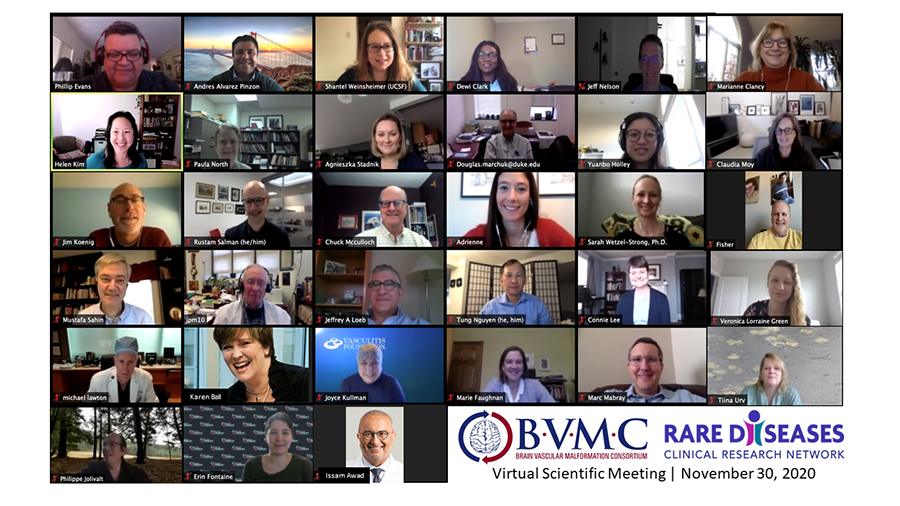
What are your current research projects?
Each of our three diseases has an associated main clinical research project, where we have established longitudinal patient cohorts—the largest of their kind; collected standardized clinical, imaging, treatment, and outcome data; and banked blood and/or tissue specimens in our biorepository for genetic and biomarker studies.
These data have provided the foundation for several seminal BVMC discoveries published during our first and second RDCRN funding cycles, including the identification of a somatic activating mutation in the GNAQ gene as a cause of SWS port wine stain, the first paper identifying a predictor that stratified hemorrhage risk in HHT patients with brain arteriovenous malformations, and the identification of inflammatory genetic modifiers involved in a novel signaling pathway involved in CCM lesion formation.
These discoveries would not have been possible without the RDCRN funding mechanism or resources provided that allowed us to establish these valuable studies as part of the BVMC. Continued longitudinal follow-up of patients enrolled in the third (current) cycle will be imperative for making progress towards validating biomarkers and addressing gaps in clinical trial readiness, including assessment of patient-reported outcomes. All three projects have potential therapeutics on the horizon for medical treatment of vascular problems and would benefit tremendously from defining relevant and measurable outcomes for clinical trials.
How has your research impacted patients?
Our research questions are guided and designed with patients in mind. Each of our patient advocacy groups (PAGs)—the Angioma Alliance, Sturge-Weber Foundation, and CureHHT—represent their respective patient communities, disseminating research information as well as providing direct input into the design and feasibility of BVMC studies. Our PAG representatives are active participants in project meetings and are voting members of our BVMC Executive Steering Committee. Thus, the patient voice is always present.
As such, our research can positively impact patients in many ways—by providing a sense of meaning and fulfillment from participating in research studies, to providing a voice for patients, to providing data that can directly impact patient management. For example, BVMC investigators have been involved in PAG-led clinical guideline papers for management of CCM, HHT, and SWS patients. Many of our BVMC research papers were cited and used in these reports as supporting evidence given the large sample size of patients recruited from multiple centers.
What new research directions or goals are you pursuing?
In the current cycle of the BVMC, all three projects will focus on clinical trial readiness to help inform trials by identifying and validating biologically relevant biomarkers that can be used for monitoring drug response or help with patient selection, and by identifying measurable outcomes for trial development.
A common theme across projects is how to best measure disease response to future treatments by either imaging, clinical criteria, functional impairment, biomarkers, or quality of life measures. Understanding the factors that influence clinical outcomes in these patients both in the treated and untreated course is critical for advancing patient care and making informed clinical decisions. These areas have been deemed high priority research needs by our PAGs and the scientific community in order to move forward with clinical trials of various proposed drug therapies in the pipeline, either under preclinical investigation or in beginning stages of Phase I/II studies.
How has being part of the RDCRN network impacted the work of your consortium?
Being a part of the RDCRN network and the resources available through the network has been instrumental in helping us achieve our scientific aims. All three BVMC projects, including 25 recruitment sites, utilize the databases designed in collaboration and hosted by the RDCRN data management and coordinating center.
In the current cycle, we are also utilizing the AMBRA imaging system to upload, annotate, and review imaging scans. Other shared resources and genetic platforms are being proposed which will also be useful for the BVMC. Without these shared resources and infrastructure, all of our rare disease research studies would be significantly delayed and cost-prohibitive to conduct.
Another advantage of the RDCRN network is learning from the experiences of other consortia and patient groups as they navigate the challenging road to getting FDA approval for drugs in their rare diseases. Learning what has worked and not worked has been invaluable for thinking through and planning how we approach the U.S. Food and Drug Administration as we work to develop therapeutics for our diseases.
How do you envision that the diseases you study can ultimately be cured?
This really depends on the disease and target. Curing the diseases may be a long way off; however, treating the brain vascular malformations that are causing neurological problems with medical therapies may be more realistic within the near term.
A number of FDA drugs approved for other indications have been shown to improve or stabilize the abnormal vascular phenotypes seen in animal models and preclinical dosing studies are underway. How safe and effective these will be in humans remains to be studied, but I am optimistic that we are getting closer to clinical trials. Even if proposed medical therapeutics do not cure the disease, as long as the vascular malformation is stabilized and prevented from growing, rupturing, or causing more problems, I consider that a huge win, especially since not everyone can be offered surgery or any interventional treatment given the location of the malformation.
Gene therapy approaches for correcting gene defects in autosomal dominant diseases are improving and may be an option for treating HHT or familial CCM in the future. Drugs such as those that target the mTOR signaling pathway, which appears to play a major role in all three of our rare diseases, may also have beneficial therapeutic effects. These are exciting scientific discoveries that have huge translational potential for patients living with our rare diseases.
The Brain Vascular Malformation Consortium (BVMC) is part of the Rare Diseases Clinical Research Network (RDCRN), which is funded by the National Institutes of Health (NIH) and led by the National Center for Advancing Translational Sciences (NCATS) through its Division of Rare Diseases Research Innovation (DRDRI). BVMC is funded under grant number U54NS065705 as a collaboration between NCATS and the National Institute of Neurological Disorders and Stroke (NINDS).

